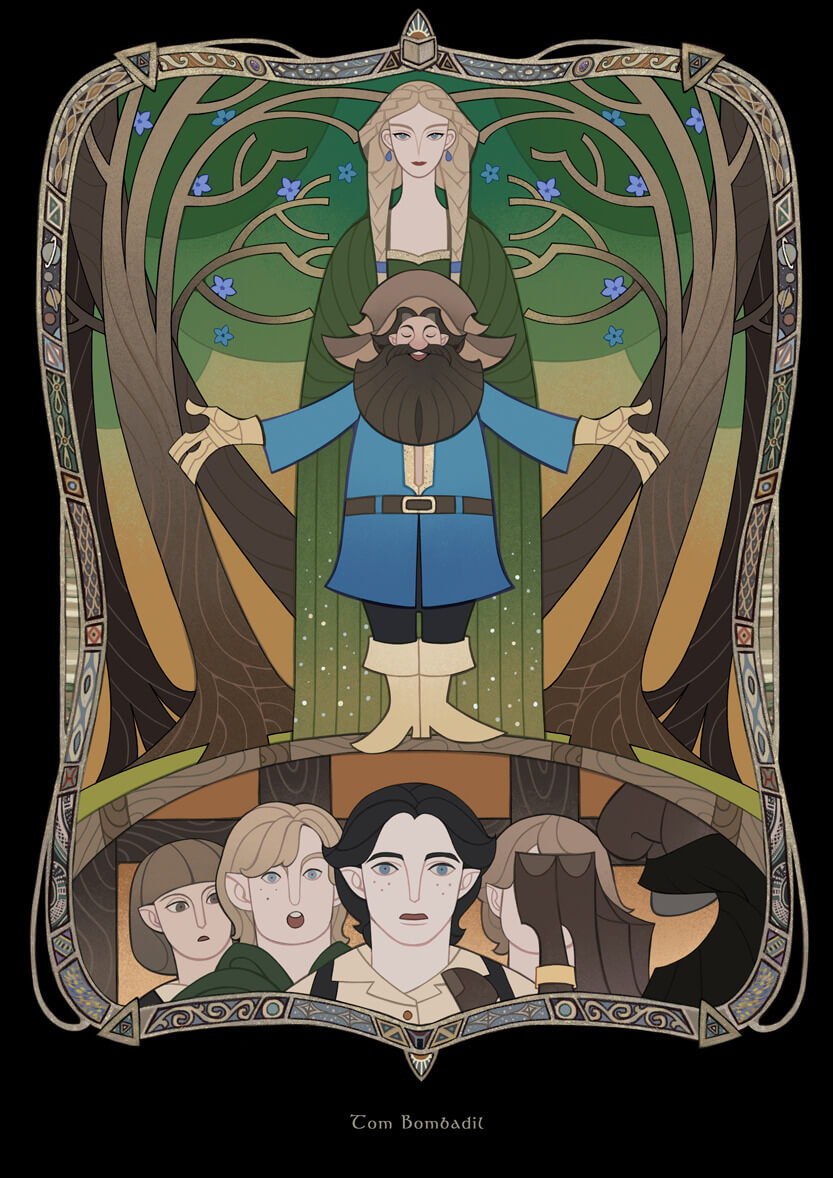It's Buckland season which means it's time for us to think about the biggest mystery in all of Tolkien's Legendarium: Tom Bombadil.
But whether you will be attending or not, it's probably time you did some deep thinking about just who Tom Bombadil is. I broke down some of the popular (and some of the more truly insane) theories for you here, so be sure and have a tinfoil hat on hand for when it gets weird.
Oh! And don't forget to grab a can of Buckland before you sit down and read this:
Buckland by Groennfell - Green Tea Mead With Lemon - Limited Spring and Summer Seasonal

$19.99
As the ground thaws, and snows melt, and green things come back to the land, Buckland Mead springs into being. Made from fresh lemon, green rooibos, and 100% wildflower honey, Buckland might just be the world's most refreshing mead. Batch Notes: … read more
Who is Tom Bombadil?
In case you are unfamiliar, Tom Bombadil is a seemingly whimsical character whom the four hobbits encounter in Lord of the Rings: The Fellowship of the Ring, while they are on their way to Bree (the town where they meet Strider/Aragorn). He only appears in the books and not the film because Director Peter Jackson didn't think he would translate well to the tone of the film. This is a legitimate concern because ol' Tommy B. is kind of.. well...
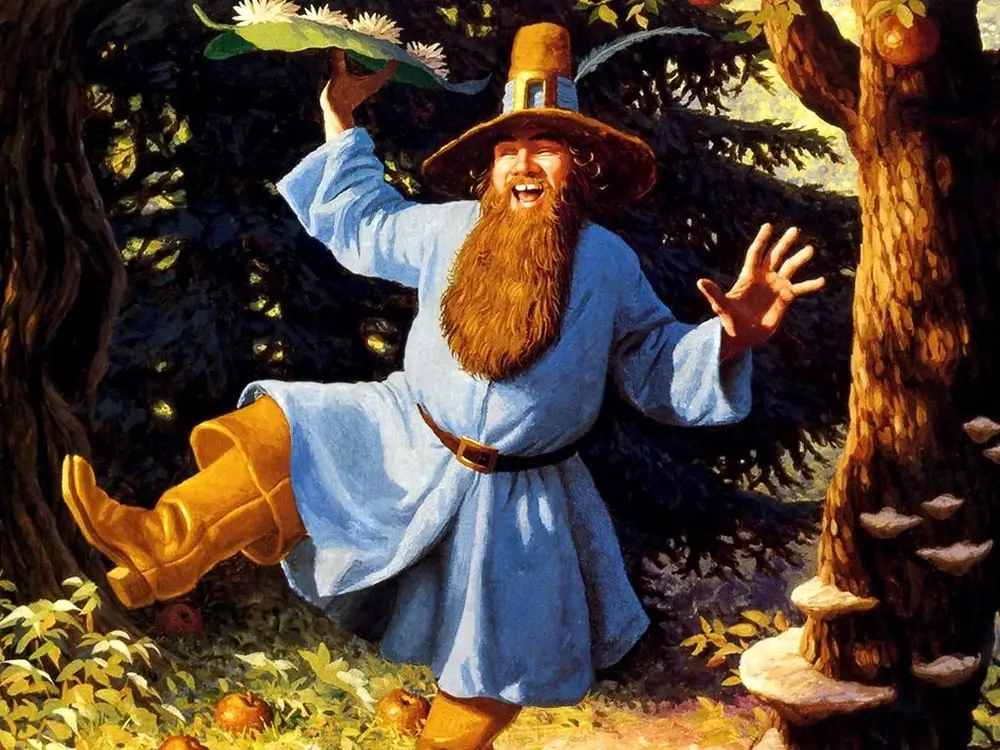
(Get a load of this guy! Source: Brothers Hildebrant)
Tom saves Merry and Pippin from certain demise when they anger an ancient tree named Old Man Willow. Then, he invites the hobbits to his home for the evening where they pass the time in a dreamlike haze, feasting, singing, and making merry with Tom's wife, Goldberry.
(Which is sort of how it felt the first time I went to Ricky the Meadmaker's house.)
But the truly freaky part happens later on in the evening: Frodo, who at this point is still a bit naïve and trusting, tells Tom about the One Ring and his quest to get to Bree and meet up with Gandalf. Tom then asks to see the Ring and Frodo just gives it to him, which, c'mon, Frodo!
Tom takes the Ring, puts it on, does NOT vanish (which is the one thing we know for sure the Ring does at this point - although even that is up for debate, but that's an article for another time), then kind of chuckles as the Ring seemingly has no effect on him and hands it back to Frodo without much todo. Frodo himself puts the Ring on (presumably to check and see if it's still working) and Tom is able to see him despite him going invisible.
Excuse me?!
To delve into the Bomba-tale for yourself, check out our Tom Bombadil Primer.
So that brings us to the real reason we are here:
What is Tom Bombadil?
Here are some theories that I have compiled over my two decades as a Tolkien reader and unofficial scholar. Some of them could be legit. Some are a little wild. Please take each with a grain of salt.
...A Wizard?
This was what I thought the first time I read the book when I was eleven. Oh! Tom must be a wizard like Gandalf, because these just seem like the sort of things a wizard would do, right? A little magic, a little wisdom imparted (he encourages Frodo to remove the Ring, not because it is dangerous but because his hand would be, 'fairer without it.')
But now I have a little wisdom myself (and many years of studying Tolkien's legendarium behind me) and I know that our friend(?) Tom is no kin of Gandalf, despite the fact that they know each other and are good buddies. For one thing, Gandalf tells us there are only five wizards in Middle Earth: the Brown Wizard, Radagast, who is definitely not Tom; Saruman the White who shows up elsewhere in Lord of the Rings; the two Blue Wizards, Alatar and Pallando, who went into the east and have not been heard from again; and, of course, Gandalf the Grey himself. Since all the Istari are accounted for, Tom probably isn't one of them.
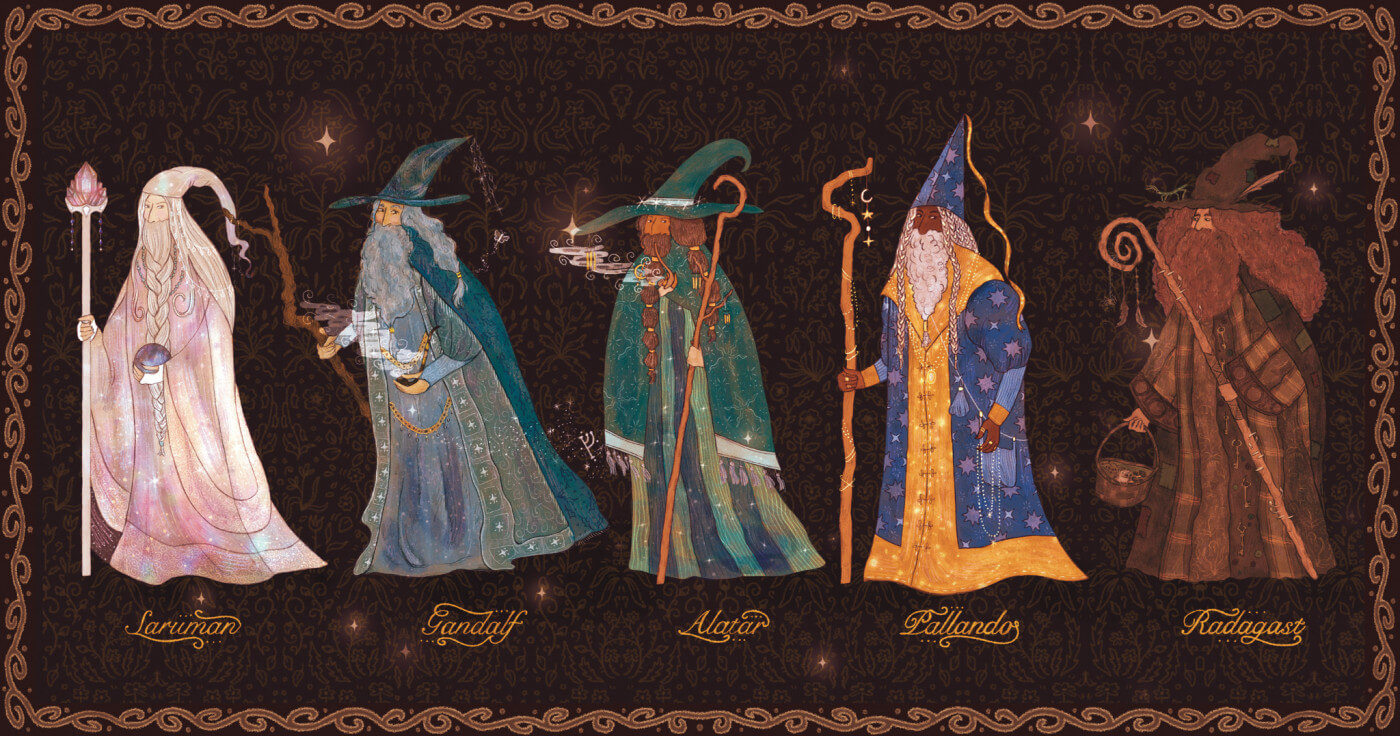
(Art by Gilfadriel)
But there is also the fact that neither Gandalf nor Saruman have quite the same reaction to the Ring that Tom does. Gandalf admits that he is tempted to take the Ring, but knows that, while he would try to use it for good, it would only be capable of committing evil acts through him. And Saruman doesn't get the chance to encounter the Ring, but he's already corrupted by the temptations of a lesser magical item, the Palantir, thanks to Sauron's interventions.
If Saruman is the strongest wizard, and he wouldn't be able to handle the Ring, Tom is probably not a wizard. At least, not by Tolkien's conventions.
...A Maiar?
The next most common guess is that he is either a Valar or a Maiar. To put it somewhat simplistically: a demi-god (Valar) or an angel made to help the demi-gods (Maiar). Together, these two groups are referred to as Ainur and they are the creators and managers of the world. (Fun fact: Istari or Wizards are a special class of Maiar specifically sent to Middle Earth to combat Sauron, who is a Maiar himself.)
But let's address the Maiar first.
As of the official record (The Silmarillion), the Ainur have all left Middle Earth by this point in time to live peacefully in Valinor with their favorite children, the elves. But we know that some of them like to secretly come back and check on Middle Earth once and a while. And some of them (like Melian, the handmaiden of Yavanna) even settled down and lived there for a while.
(Art by Wavesheep)
However, I don't think that Tom is a Maiar. Like I mentioned above about the Istari, the Maiar we encounter are unable to resist the pull of the Ring. Even Sauron himself is, in a way, beholden to it despite being the actual Lord of the Rings, to the point that its destruction nearly completely unmakes him. And Sauron was a Maiar named Mairon, servant to the smith Valar, Aule, before Melkor seduced him and turned him into Sauron.
The point is, Maiar are easy to corrupt.
Tom is incorruptible.
Tom is not a Maiar.
...A Foil to Sauron?
I saw this theory for the first time while I was putting together my research for this article and I'm intrigued by it. I think this quote from this Quora post explains it best:
"...but, unlike Sauron, [Tom] chooses not to rise up in arms. He provides aid to the traveling hobbits, but he will not fight for nor with them. And, in the end, and against all odds, he lives, while Sauron is reduced to an impotent shade. So, then, who is mightier? He who comes up in arms to seek his ends, or he who resists temptation and remains tranquil, righteous, and resolute, while beset by evil?
While Sauron could not even conceive of losing (as it never occurred to him that a mortal might try to destroy The Ring), Bombadil sat smoking his pipe.
Bombadil represents the power of faith and righteousness. He is the embodiment of what it means to defy temptation and animosity; to stray from the path of goodness never occurs to him.
Though I'm not Catholic (as Tolkien was) the message is clear: Have faith, for God moves in mysterious ways."
$19.99
As the ground thaws, and snows melt, and green things come back to the land, Buckland Mead springs into being. Made from fresh lemon, green rooibos, and 100% wildflower honey, Buckland might just be the world's most refreshing mead. Batch Notes: … read moreBuckland by Groennfell - Green Tea Mead With Lemon - Limited Spring and Summer Seasonal

...A Physical Embodiment of the Music of the Ainur/The very essence of Arda?
This is a fun tinfoil hat theory that I actually really like. The cosmology of Tolkien's world involves the chief god, Eru Ilúvatar, enlisting the Ainur to make a song. Tolkien describes them as singing, but I like to picture it like each Valar and Maiar play a different instrument in an orchestra.
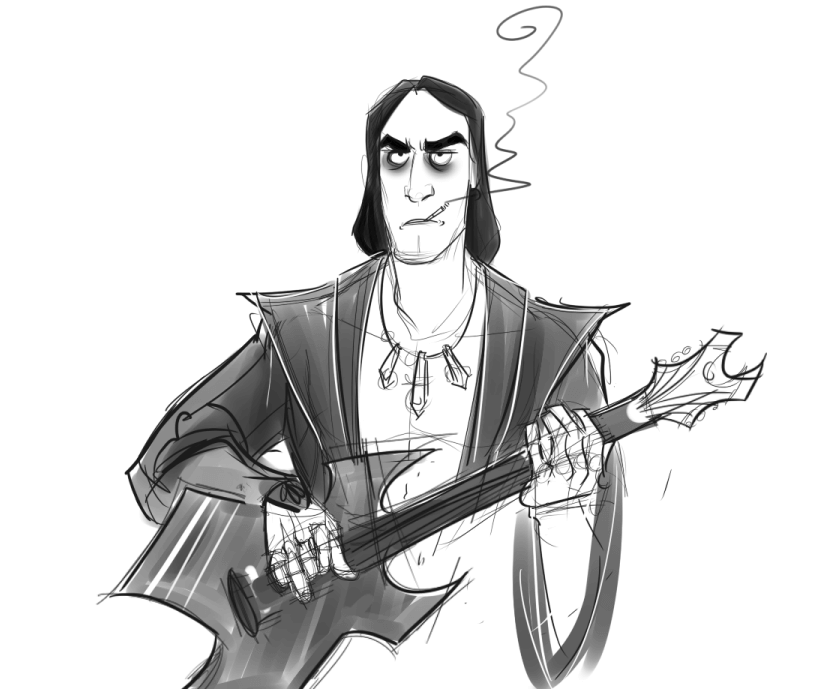
(Obviously, Sauron's predecessor Melkor plays the electric guitar. Art by Ikkanrana)
They create a great piece of music and it plays out before them in the first book of the Silmarillion, The Ainulindalë. While playing it, they see the world and all of time playing out before them. And while they are expected to play what Eru Ilúvatar wants of them, like any great conductor, he also expects them to improvise to assist in the development of the piece (something that Melkor takes to most readily)
What is left is the music of the world. Everything that happens in Arda (Tolkien's world) is a result of this music.
When Frodo asks Goldberry about Tom, she says,
"'He is,' said Goldberry, staying her swift movements and smiling. Frodo looked at her questioningly. 'He is, as you have seen him,' she said in answer to his look. 'He is the Master of wood, water, and hill.”
And then Tom says:
"Eldest, that’s what I am. Mark my words, my friends: Tom was here before the river and the trees; Tom remembers the first raindrop and the first acorn. He made paths before the Big People, and saw the little People arriving. He was here before the kings and the graves and the Barrow-wights. When the elves passed westward, Tom was here already, before the seas were bent. He knew the dark under the stars when it was fearless – before the Dark Lord came from Outside."
Given the cosmology of Arda, doesn't that sound exactly like what he means?
...Tolkien Himself?
Could it be that, like Stephen King after him, J.R.R. Tolkien wanted his own place in the universe of his creation? Tom is a lot like the professor. He likes nature, singing, smoking a pipe, and eating. He loves his wife. But then again, that could mean that Tom Bombadil is all of us, right?
But no, Tolkien already has his self-insert character: Beren, from The Silmarillion, is how he imagined himself. And Beren's wife, Luthien, is how Tolkien thought of his own beloved wife, Edith. When Edith passed away, Tolkien wrote to his son John:
"I never called Edith Lúthien – but she was the source of the story that in time became the chief part of The Silmarillion. It was first conceived in a small woodland glade filled with hemlocks at Roos in Yorkshire (where I was for a brief time in command of an outpost of the Humber Garrison in 1917, and she was able to live with me for a while). In those days her hair was raven, her skin clear, her eyes brighter than you have seen them, and she could sing – and dance. But the story has gone crooked, & I am left, and I cannot plead before the inexorable Mandos.”
In this case, while Tom and Tolkien have a lot in common, I don't think this theory quite hits the mark.
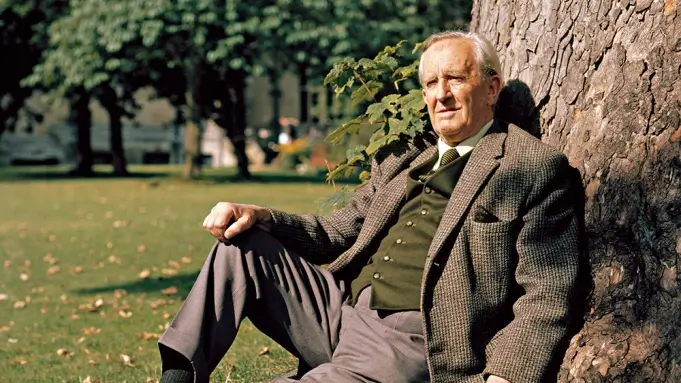 (Hanging out with Old Man Willow. Picture courtesy of the Tolkien Estate.)
(Hanging out with Old Man Willow. Picture courtesy of the Tolkien Estate.)
...Whatever Ungoliant Is?
There is another creature in Tolkien's writings that has enigmatic origins. Ungoliant, from The Silmarillion, is a great spider queen who came to be outside of the cosmology of the world. She literally exists outside the theology explained in The Ainulindalë. We encounter her when she one day falls out of the Void that exists beyond the known world and her creation and existence are never explained.
Just like Tom Bombadil.
And to be fair, Ungoliant isn't the only unknowable creature encountered in Tolkien's world. When Gandalf falls beneath Moria with the Balrog, he encounters creatures and beings he does not know nor understand.
Ungoliant is a creature of great hunger and that drives her to commit foul and evil acts as she aligns herself (for a time) with Melkor. But even Melkor the Dark Lord becomes afraid of her hunger eventually.
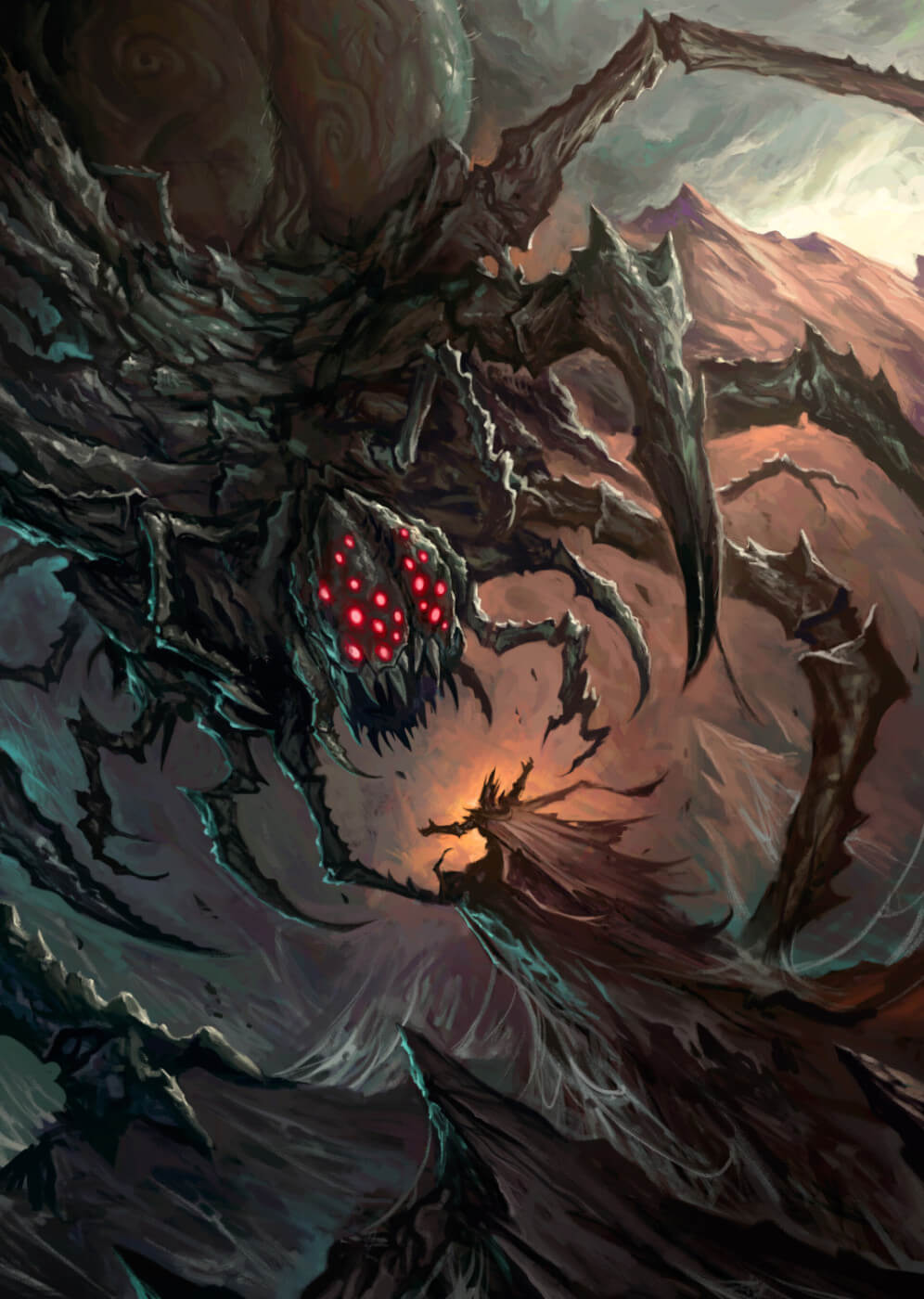
(Ungoliant and Melkor by Diana Franco)
Is Tom is the opposite of her? Ungoliants want to eat everything. Tom desires nothing. Not even the One Ring. Sure, he eats and smokes and sings songs and loves his wife, but he is never shown coveting any of these things or jealously guarding them. He just exists among them in peace.
And on that note...
...Evil?
If you read the Fellowship of the Ring and got shivers down your spine when Tom interacted with the Ring, you wouldn't be the first.
This LiveJournal entry has made the rounds for the last twelve or so years, and I have to admit, it's very compelling. It explains a lot about the strange tone of the chapter: the dangers the hobbits encounter in this dangerous land that is supposedly run by benevolent ol' Tom.
After all, two hobbits can run around Mordor for quite some time with little danger, but four hobbits nearly died immediately upon entering Tom Bombadil's forest!
...A God/Valar?
We already spoke of the Maiar, but what about their more powerful counterparts, the Valar?
Check out this passage:
‘When they caught his words again, they found that he now had wandered into strange regions beyond their memory and beyond their waking thought, into times when the world was wider, and the seas flowed straight into the western shore, and still on and back Tom went singing out into ancient starlight when only the Elf-sires were awake.’ This shows that Tom certainly has the age and the knowledge of the Ainur, and came into being possibly even before the First Age of the world. He tells them: “Mark my words, my friends - Tom was here before the river and the trees, Tom remembers the first raindrop and the first acorn. He made paths before the Big People, and saw the little people arriving.”
With what we learn of the Valar in The Ainulindalë, this feels on track for some kind of godly power.
But here's the thing: if Tom is a Valar, then we need to decide if he is a known or unknown Valar (since the Silmarillion tells us that not all of them are named within the book, just the most important ones).
It seems unlikely that Tom would be as powerful as he is and yet remain one of the unnamed Valar, but it could happen. If that's the case, then we've come to a standstill on that line of logic. So let's go in the other direction: if he is a named Valar, which named Valar is he?
Each Ainur has a special realm that they serve. For instance, Manwë is the Lord of the winds and Ulmo is the Lord of all waters. Neither of them seems right for Tom; although Tom calls Goldberry 'River's daughter,' so maybe she is a Maiar of Ulmo? But Ulmo's only named female Maiar is Uinen who cares for sea creatures and that doesn't sound very Goldberry.
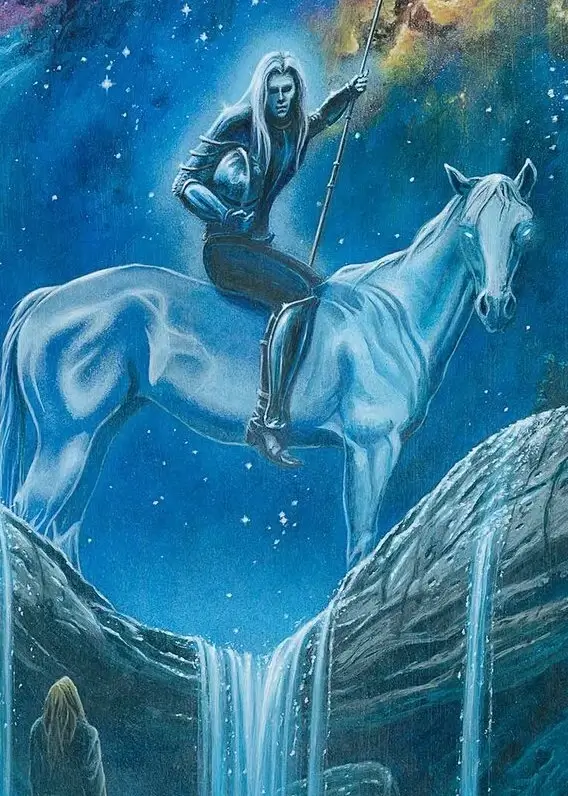
(Art by Kip Rasmussen)
Oromë is the Valar of the forests and he is represented as a great and jolly huntsman. That kind of sounds like Tom! Oromë is also one of the few Valar known to come and go from Middle Earth after the Valar formally leave. And he is married to Vána, who is the Lady of flowers and youth and who is well-known for her flowers. Which does sound like Goldberry; however, Vána doesn't really have anything to do with rivers.
But Vána does have a sister: Yavanna, who is the Lady of all growing things, specifically trees and plants. Her husband Aulë is the Valar of smithing but he also forged the structure of the earth, so we have him to thank for things like mountains. Yavanna is the one Valar who loves Middle Earth and remains with it long after the others have returned to Valinor. Where Valinor is very structured and idyllically beautiful, Yavanna lets Middle Earth grow wild.
I'm going to put my tinfoil hat on again for a second, so please excuse me:
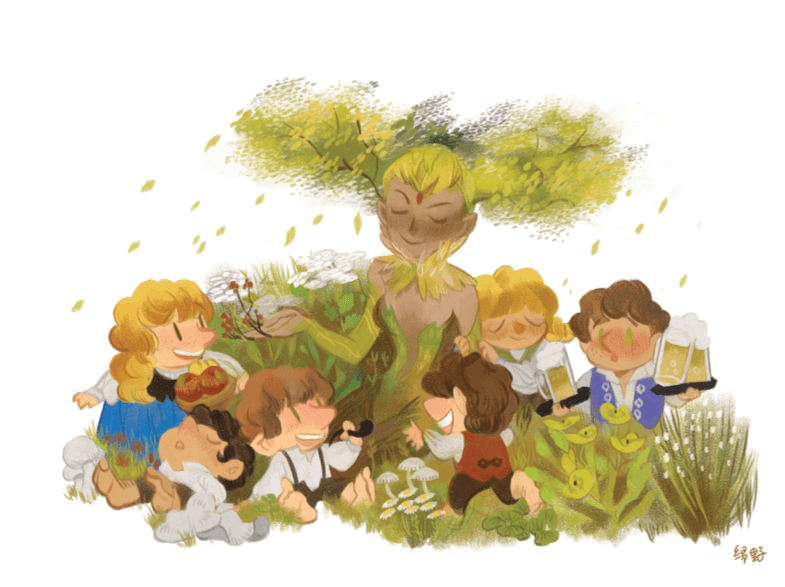
(Yavanna with the hobbits by Cochart.)
Aulë did a weird thing in the Silmarillion which he got into a lot of trouble for: he made Dwarves. After the creation of the Elves and Men, he wanted to make some people too! When the head god Eru Ilúvatar found out, he was upset and demanded that the Dwarves be destroyed. Eventually, however, he let Aulë keep them so long as they woke up after Elves and Men.
Yavanna got salty and wanted her own people too, so she made the Ents.
However, there is a long-running fan theory that Yavanna also secretly made hobbits, too. (There is another theory that Vana is the actual creator of hobbits!)
Hobbits and Yavanna have a lot in common, and while Tolkien claimed that hobbits are simply an offshoot of Men, Gandalf tells Frodo once that hobbits have a secret history they do not remember but he does. As a Maiar, Gandalf was around when the races were being made, and he is known to be the wisest of all Maiar.
Me stretching to propose this theory.
Given the special interest that Tom and Golberry have in the hobbits, given the fact that they live right outside the Shire, given all their gardens, their love of feasting and pipes and songs (all things hobbits love), given his disdain for the power the Ring offers (which, hobbits themselves prove surprisingly resilient to its corruption since they only really want peace and good-tilled earth)...
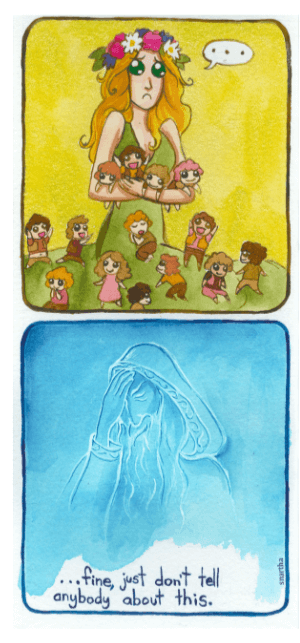
(Art by Snartha)
...What if Tom is Aulë and Goldberry is Yavanna?
Ok, ok, I'll take the hat off. I honestly do think this theory is a big stretch and I don't really believe it (though I will proudly die on the Yavanna-or-Vana-made-the-hobbits hill!)
I think it just kind of misunderstands all four characters involved and tries really hard to hammer some square pegs into some round holes.
...The God?
Could Tom be Eru Ilúvatar himself?
I don't think this one is as much of a stretch as that last one (my arms hurt!). And this theory is actually one of the more popular ones.
For one, Tom is always singing and that is literally how Eru Ilúvatar made the entire world.
For another, he refuses the burden of the Ring. Eru Ilúvatar is notorious for refusing to fix the problems mortals (and elves) have in Middle Earth. The Council of Elrond even discusses giving him the Ring at one point.
Elrond says, "“I had forgotten Bombadil, if indeed this is still the same that walked the woods and hills long ago, and even then was older than the old. That was not then his name. Iarwain Ben-adar we called him, oldest and fatherless.”
But they decide against it because he would either not care as it is so far beneath him or he would lose it because he couldn't be bothered.
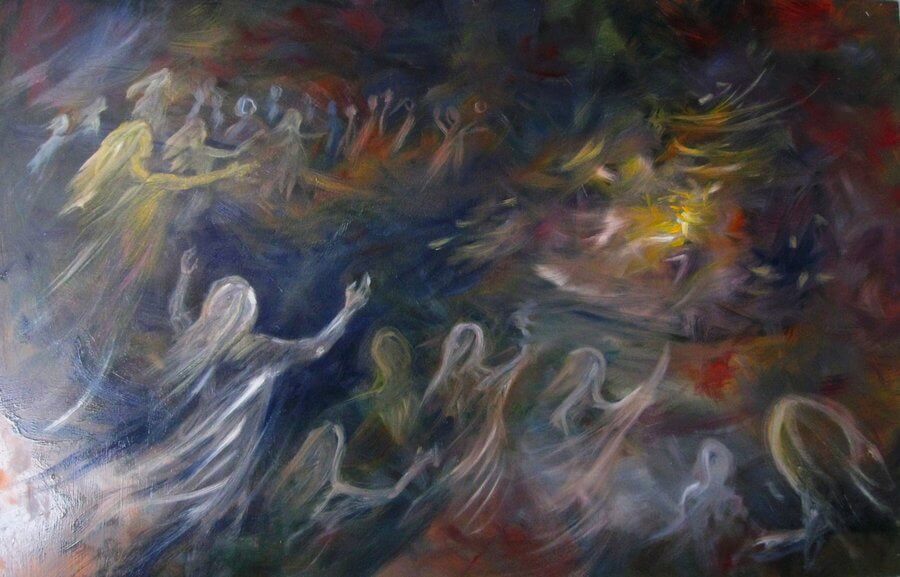
(Art by Anna Kulisz)
Eru Ilúvatar is fatherless and the oldest for sure. And there isn't anyone else in the canon who dealing the Ring would be as far beneath as the creator.
And again, let's revisit this passage:
"“‘Fair lady!’ said Frodo again after a while. ‘Tell me, if my asking does not seem foolish, who is Tom Bombadil?’
“‘He is,’ said Goldberry, staying her swift movements and smiling.”"
Tolkien was a devout Catholic. He is, is very close to what the Abrahamic God tells Moses: "I AM WHO I AM. Say this to the people of Israel: I AM has sent me to you."
...An Intentional and Unsolvable Mystery?
Maybe the true Tom Bombadil was the friends we made along the way?
No, that's not what I meant to say. Ahem.
Maybe the whole point of Tom Bombadil is that we aren't supposed to know who or what he is. Tolkien spent so much time and effort defining and categorizing every little thing in his world, giving elaborate ancestries to heroes, tracing the lineage of artifacts throughout eon after eon, crafting elaborate cosmologies for locations and how they came to be.
But The Lord of the Rings is a story about magic. And the difference between magic and science is that magic is unknowable. Tolkien's magic is especially unknowable. Gandalf doesn't cast Magic Missile for 1d4+1 force damage at his enemies. In fact, our wizard's use of magic is very rare and very unexplained (except for those dope fireworks). This isn't a Brandon Sanderson novel where magic has rules. The very essence of the definition of magic is that it defies rules!
Tolkien loved the magic of old Norse and Finnish mythology and he studied it intently for his world. But he also loved the natural, growing world. And some of the greatest magic we can still encounter in our modern, connected, scientific world comes from the mysteries we find in nature.
What if Tom Bombadil is something that just... grew? Without Eru Ilúvatar's knowledge or permission? Like a weed in a perfectly planted garden?
This is my personal theory. But I have some backup. In 1954, Tolkien wrote in a letter:
"And even in a mythical Age, there must be some enigmas, as there always are. Tom Bombadil is one (intentionally)."
What do YOU think Tom Bombadil is? Which of these theories strikes most true for you? Did we miss one? Be sure and tell us in the comments!
$19.99
As the ground thaws, and snows melt, and green things come back to the land, Buckland Mead springs into being. Made from fresh lemon, green rooibos, and 100% wildflower honey, Buckland might just be the world's most refreshing mead. Batch Notes: … read moreBuckland by Groennfell - Green Tea Mead With Lemon - Limited Spring and Summer Seasonal



